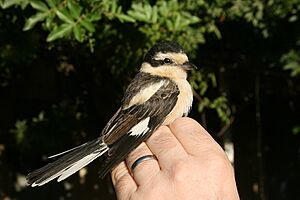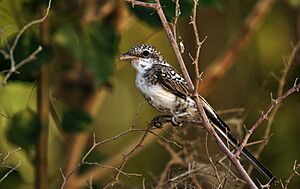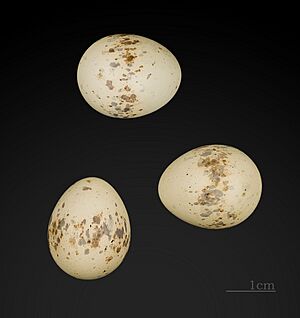Masked shrike facts for kids
Quick facts for kids Masked shrike |
|
|---|---|
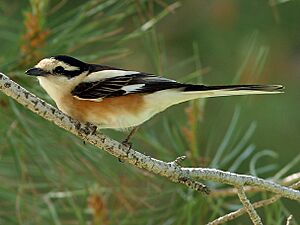 |
|
| Male | |
| Conservation status | |
| Scientific classification | |
| Genus: |
Lanius
|
| Species: |
nubicus
|
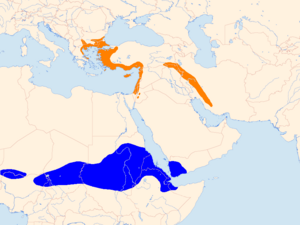 |
|
Summer Winter |
|
The masked shrike (Lanius nubicus) is a small bird in the shrike family. It breeds in southeastern Europe and near the eastern Mediterranean Sea. You can also find a separate group of them in eastern Iraq and western Iran.
These birds are migratory, which means they fly long distances. They spend their winters mainly in northeast Africa. Even though they usually travel shorter distances, some masked shrikes have been seen far away in places like northern and western Europe. This bird is the smallest in its group, with a long tail and a special hooked beak.
Male masked shrikes have mostly black upper parts with white on their head and large white patches on their shoulders and wings. Their throat and belly are white, with orange on their sides and chest. Females look similar but are a bit duller, with brownish-black upper parts. Young birds are grey-brown with bars on their bodies. Masked shrike calls are short and rough, but their song is quite pretty, sounding like a warbler.
Masked shrikes like to live in open woodlands with bushes and some big trees. They are not as easy to spot as some of their relatives. They build a neat, cup-shaped nest in a tree. The female usually lays 4–6 eggs and sits on them for about two weeks. Both parents feed the chicks until they are ready to fly, which is about 18–20 days after hatching. The young birds stay with their parents for a few more weeks. Masked shrikes mostly eat large insects, but sometimes they catch small animals. They might even stick their prey on thorns or barbed wire! Even though their numbers are going down in some parts of Europe, they are not decreasing fast enough to be a big worry. Because of this, they are listed as a species of least concern by conservation groups.
Contents
What is a Masked Shrike?
Shrikes are a family of birds that are usually thin and have long tails. Most of them belong to the group called Lanius, which are known as typical shrikes. These birds have short necks, rounded wings, and a hooked tip on their beak. Most shrikes live in open areas.
The masked shrike was first described by a German explorer and naturalist named Martin Lichtenstein in 1823. Its scientific name is Lanius nubicus. The word Lanius comes from Latin and means "butcher." This name refers to how shrikes often stick their prey on thorns, like a butcher hanging meat. The word nubicus means "Nubian," which refers to northeast Africa, where these birds are found.
The English name "shrike" was first used in 1545 and comes from the loud, shrill calls these birds make. They are also sometimes called "butcher-birds" because of their unique way of storing food.
How to Spot a Masked Shrike
The masked shrike is the smallest bird in its group. It is a slender bird that usually weighs about 20 to 23 grams (0.7 to 0.8 ounces). It is about 17 to 18.5 centimeters (6.7 to 7.3 inches) long, and its wingspan is about 24 to 26.5 centimeters (9.4 to 10.4 inches). It has a long tail and a fairly small beak. On each side of its upper beak, there is a small, triangular ridge that fits into a notch in its lower beak. This special beak helps it to hold and tear its food.
Male masked shrikes have mostly black upper parts. Their crown, forehead, and the stripe above their eye (called a supercilium) are white. They have large white patches on their shoulders and the main flight feathers of their wings. The outer tail feathers are also white. Their throat, sides of their neck, and underparts are white, with orange on their sides and chest. Their eyes are brown, their beak is black, and their legs are dark brown or black.
Female masked shrikes look a bit like the males but are less bright. Their upper parts are brownish-black, and the white patches on their shoulders and underparts might have a grey or buff color. Young masked shrikes have grey-brown upper parts with darker bars from their head to their back. Their forehead is paler grey, and their underparts are off-white with bars. Their wings are brown, but they still have white patches on their main flight feathers.
Masked shrikes look most like woodchat shrikes, but they are smaller, thinner, and have longer tails. Adult masked shrikes are easy to tell apart from woodchat shrikes because masked shrikes have white on their head and a dark lower back, while woodchat shrikes have a black crown, a rusty neck, and a white lower back. Young birds are more similar, but the masked shrike has a longer tail, a paler face, and a grey back.
Voice of the Masked Shrike
The masked shrike makes harsh calls, which are typical for this bird family. They often repeat sounds like tsr, tzr, or shek, and sometimes make whistling noises. When they are worried, they make a rattling krrrr sound. If they are very upset, they might snap their beak.
Their song can last up to a minute and is soft for a shrike. It includes chattering sounds mixed with rich, musical warbles. It sounds a bit like the songs of some warblers. Sometimes, male masked shrikes even sing while flying.
Did you know? In the movie The Great Escape, the prisoners of war learned how to copy the masked shrike's call!
Where Masked Shrikes Live
The masked shrike breeds in the Balkans and Western Asia. This includes southern Bulgaria, eastern North Macedonia, northeast Greece and some Greek islands, Turkey, Cyprus, and from Syria south to Israel. They also nest in eastern Iraq and western Iran.
These birds are migratory. They fly south of the Sahara Desert for the winter, mostly to Chad, Sudan, and Ethiopia. Smaller groups can be found further west in eastern Mali and Nigeria, and in northern Kenya and southern Saudi Arabia. Most masked shrikes leave their breeding areas in late August and September and fly back north in February and March.
This species is seen in Egypt, Jordan, and Israel more often in spring than in autumn. This suggests that their journey south might be more concentrated further east. When they are migrating, these birds can hold small territories. Unlike other shrikes, they might gather in large groups. More than 100 have been seen in one place in Israel, with five birds in a single bush! Masked shrikes have also been seen by chance in places like Algeria, Finland, Spain, and Sweden.
Masked shrikes prefer open woodlands with bushes and some large trees. Unlike their relatives, they avoid very open areas with little plant life. They also use orchards and other farmed lands that have old trees or big hedges. They are usually found in more wooded areas than other shrikes that live in the same region. They live in lowlands and on hills up to 1,000 meters (3,300 feet) high. In some places, they breed at even higher altitudes, up to 2,000 meters (6,600 feet). During migration and in winter, they might be found in gardens and resorts. They still prefer open areas with thorny bushes and large trees like acacia or eucalyptus.
Masked Shrike Behavior
The masked shrike is a bird that likes to be alone, except when it is migrating. It protects its breeding territory, which is about 2 to 5 hectares (5 to 12 acres) in size. It also defends a territory of about 3 hectares (7.4 acres) in its wintering grounds. Even though it is not afraid of humans, it can be aggressive towards other masked shrikes and other birds that enter its territory.
Most other shrikes sit on high, open branches all year round. However, the masked shrike only uses these noticeable spots at the beginning of the breeding season. At other times, it chooses lower, more hidden places. It sits upright and often bobs its tail. It has an easy, graceful flight. One masked shrike was even seen pretending to be hurt when it was caught, only to act normal again when the danger was gone.
Reproduction and Life Cycle
Male masked shrikes sing from perches in their territories starting in early April. They sometimes chase or sing against other males nearby. The male's courtship display, which usually includes singing, begins with the bird sitting straight up and shaking its wings on an open branch. Then, the shrike walks down the branch and bows, either while moving or when it stops for a moment. The male might also fly in a fluttering, zigzag pattern to impress the female. Sometimes, the male feeds the female while she crouches with her wings spread and makes begging calls.
Both the male and female build the nest. It is a small, neat cup made of roots, stems, and twigs, lined with soft materials like wool or hair. They decorate the outside with lichen. The nest is built in a tree, usually about 1.5 to 10 meters (5 to 33 feet) above the ground. It is about 170 millimeters (6.7 inches) wide and 65 millimeters (2.6 inches) deep. The inside cup is about 75 millimeters (3 inches) across and 35 millimeters (1.4 inches) deep.
Eggs are laid from April to June, mostly in May in lower areas and about a month later in the mountains. If a nest fails, the birds might lay new eggs in June or July. It seems that having a second group of chicks is common in some areas. The parents sometimes destroy their first nest to use the materials for a new one.
The eggs are about 20 by 16 millimeters (0.8 by 0.6 inches) in size and can vary in color. They usually have a background of grey, cream, or yellow, with faint grey spots and a ring of brown marks. A normal group of eggs (called a clutch) is 4–6 eggs. The female sits on the eggs for 14–16 days until they hatch. The baby chicks are born helpless and covered in downy feathers. Both parents feed them until they are ready to fledge (fly), which is about 18–20 days later. The young birds depend on their parents for about 3–4 weeks after leaving the nest. Masked shrikes can start breeding when they are one year old.
What Masked Shrikes Eat
Like other shrikes, the masked shrike hunts from a perch, usually about 3 to 8 meters (10 to 26 feet) high. However, they often choose more hidden spots than most other shrikes. They usually catch their prey from the ground, but sometimes they pick insects off leaves or catch them in the air, flying like a flycatcher.
They might stick their prey on thorns or barbed wire. This is like a "larder" or pantry, where they can store food to eat right away or later. Since shrikes have fairly weak legs, sticking the prey helps them hold it while they pull it apart. It was once thought that only male shrikes did this during breeding season, but now we know that both male and female masked shrikes stick their prey in winter and during migration. Sometimes, individual birds can be very tame, following a gardener or feeding close to people watching them.
The masked shrike mainly eats large insects. However, they also catch other small creatures with exoskeletons (like spiders) and small animals with backbones. Shrikes eat a lot to get fat before they migrate, but not as much as some other birds. This is because they can find food along the way. They sometimes even catch other tired migrating birds. Even though the masked shrike is quite small, it has been seen killing birds like the lesser whitethroat and the little swift. They kill small animals by hitting them on the back of the head with their beak. Then, they use the special teeth on their beak to separate the neck bones.
Masked Shrike Conservation Status
The International Union for Conservation of Nature (IUCN) estimates that there are between 105,000 and 300,000 masked shrikes in Europe. This suggests a total global population of about 142,000 to 600,000 birds. Even though the number of masked shrikes seems to be going down, the decrease is not happening fast enough to be a major concern for the IUCN. Because there are many of these birds and they live in a large breeding area (about 353,000 square kilometers or 136,000 square miles), this shrike is classified by the IUCN as being of least concern.
In recent years, the number of masked shrikes has decreased in Europe. However, countries like Bulgaria, Greece, and Cyprus still have thousands of breeding pairs. Turkey is a very important place for them, with up to 90,000 pairs. The species is declining in Greece and Turkey because they are losing their natural homes. A big drop in numbers in Israel is thought to be due to pesticides. In Somalia, this bird is now rare.
Migrating masked shrikes are sometimes shot in countries around the eastern Mediterranean, even though they are legally protected in most places. There is also some hunting of breeding birds in Greece and Syria, where this species is thought to bring bad luck. There are signs that this shrike is learning to live in planted forests instead of natural woodlands. This could help their populations in the future.



